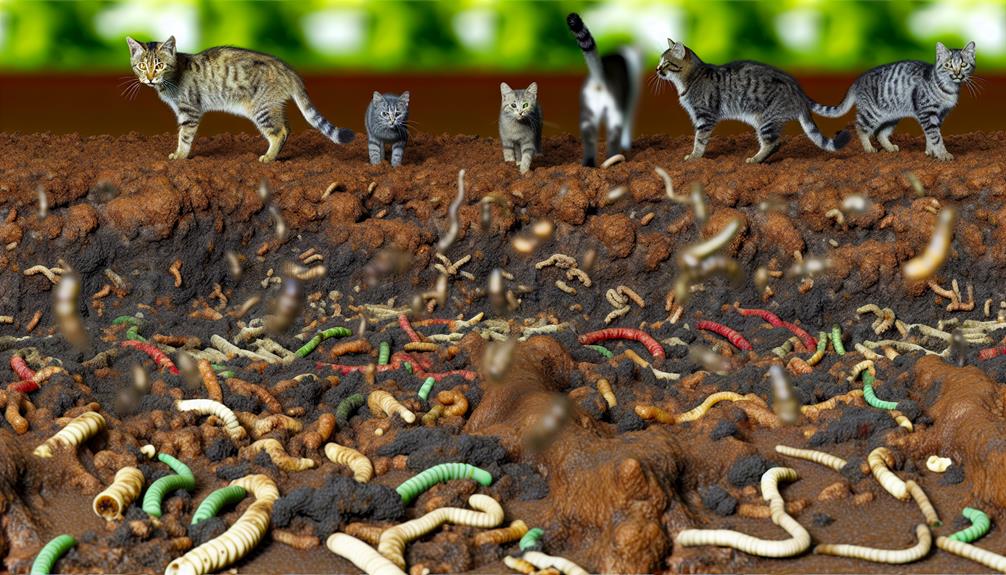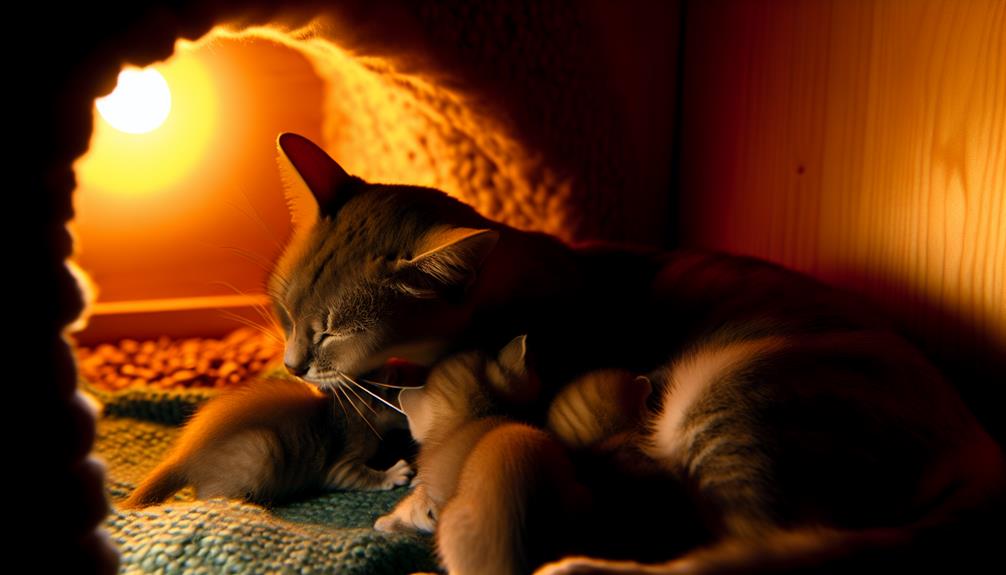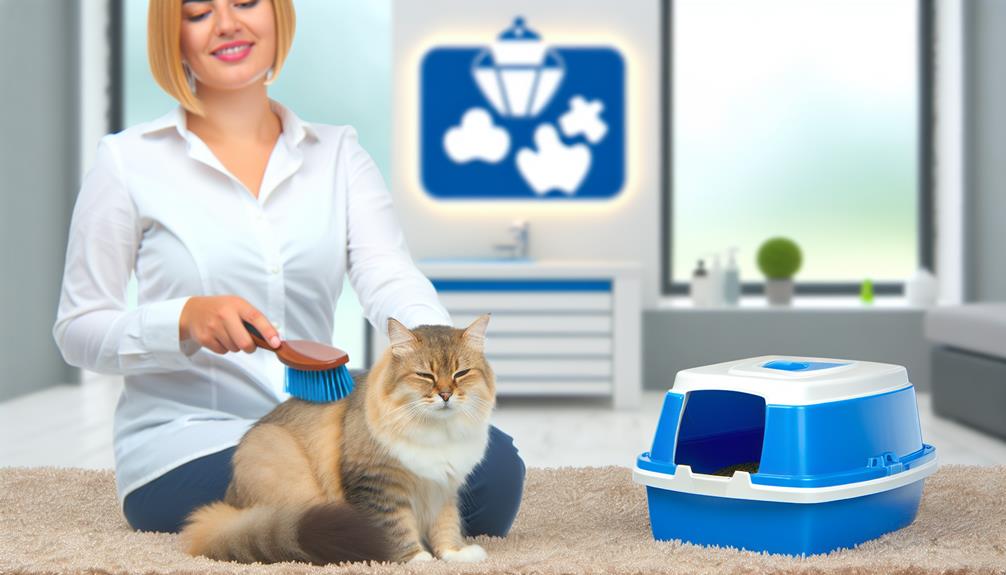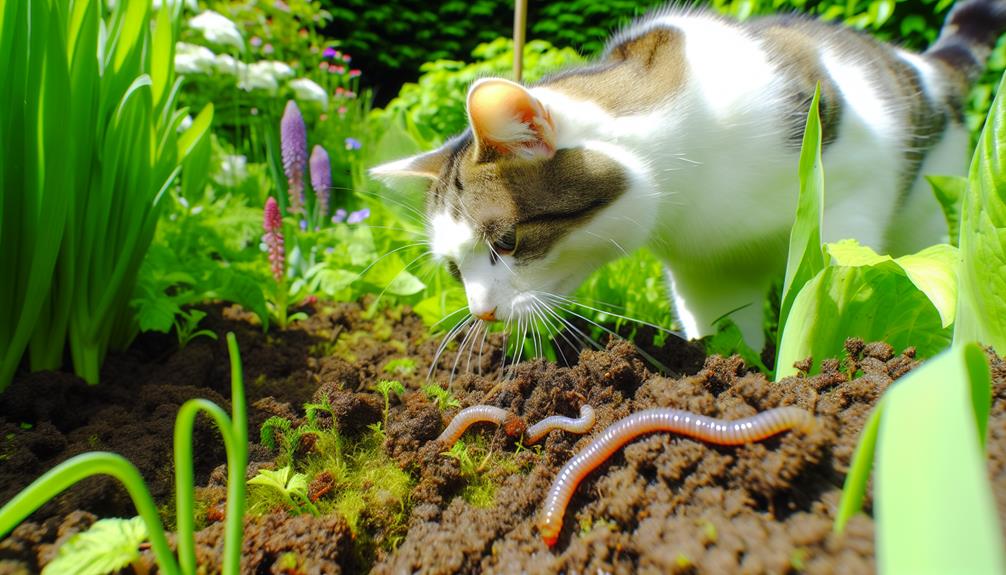When it comes to your feline friend picking up some unwelcome guests, it's not just a matter of bad luck. Cats can get worms through various ways that might surprise you. Whether it's from hunting small critters, interacting with other animals, or simply exploring contaminated environments, the risks are everywhere. Even a mother cat can pass these parasites to her kittens. Knowing how worms find their way into your cat's system is essential. So, what steps can you take to protect your pet? Let's explore the different transmission pathways and preventive measures you can adopt.
Types of Worms in Cats
When discussing feline parasitic infestations, it's important to understand the various types of worms that can affect cats. The most common parasitic worms include roundworms and tapeworms, each presenting unique symptoms and life cycles that are significant for effective diagnosis and treatment.
Roundworms, or Toxocara cati and Toxascaris leonina, are among the most prevalent parasitic worms in cats. The roundworm lifecycle begins when cats ingest the eggs, either from contaminated soil or through hunting small animals. Once ingested, the eggs hatch into larvae within the intestines. These larvae then migrate through the liver and lungs before returning to the intestines to mature into adult worms. You might notice symptoms such as a pot-bellied appearance, vomiting, diarrhea, and weight loss in infected cats. Diagnosing roundworms typically involves a fecal flotation test to detect eggs in the stool.
Tapeworms, primarily Dipylidium caninum, are segmented worms that attach to the small intestine. Tapeworm symptoms include weight loss, perianal itching, and the presence of rice-like segments in the cat's feces or around the anus. Cats usually acquire tapeworms by ingesting infected fleas, which act as intermediate hosts. In diagnosing tapeworms, a veterinarian may perform a fecal examination or visually identify tapeworm segments.
Understanding these parasitic worms' symptoms and lifecycles is critical for accurate diagnosis and effective treatment. Regular deworming and preventive measures, such as flea control, are important in managing these infestations. If you suspect your cat has worms, consulting a veterinarian for proper diagnosis and treatment is essential.
Transmission From Other Animals
Understanding the transmission of parasitic worms from other animals is essential for effective prevention and treatment. Inter animal transmission of parasitic worms occurs primarily through predation, scavenging, or close contact with infected hosts. Cats, being natural hunters, are particularly susceptible to contracting worms from small mammals, birds, and even other felines. These intermediate hosts often harbor larval stages of parasites, completing significant parts of the parasite lifecycle within them.
For instance, tapeworms (Dipylidium caninum) rely on fleas as intermediate hosts. When a cat ingests an infected flea during grooming, the tapeworm larvae are introduced into its gastrointestinal tract, where they mature into adult worms. Similarly, roundworms (Toxocara cati) can be transmitted through the ingestion of rodents carrying larval worms. Once inside the feline host, these larvae migrate through tissues to reach the intestines, where they develop into adult worms.
Diagnostic approaches for detecting inter animal transmission involve fecal examinations to identify worm eggs or larvae, as well as serological tests for specific parasitic antigens. A thorough history of the cat's hunting behavior and contact with other animals should also be obtained to assess risk factors. Preventive measures include regular deworming protocols, flea control, and restricting access to potential intermediate hosts.
Contaminated Environments

While inter animal transmission is a considerable route for parasitic worms, another major source of infection is through contaminated environments. Cats can acquire parasitic worms such as roundworms, hookworms, and tapeworms from environments contaminated with fecal matter or soil harboring these parasites' eggs and larvae. Maintaining excellent litter box hygiene is essential to mitigate the risk of your cat contracting worms.
Frequent litter box cleaning helps prevent the accumulation of worm eggs and larvae, which can be ingested when your cat grooms itself. It's recommended to scoop the litter box daily and perform a thorough cleaning weekly using hot water and mild detergent. Be sure to wear gloves during this process to avoid personal contamination.
Outdoor exposure considerably elevates the risk of your cat encountering contaminated environments. Soil, particularly in areas frequented by other animals, can be laden with parasitic eggs or larvae. Cats that roam outdoors are more likely to come into contact with these infected soils, especially in gardens, parks, or communal areas. To minimize this risk, consider restricting your cat's outdoor access or supervising their time outside.
Clinical signs of worm infestation acquired from contaminated environments can include vomiting, diarrhea, weight loss, and a distended abdomen. If you suspect your cat has been exposed to a contaminated environment, consult your veterinarian for diagnostic testing such as fecal flotation or antigen tests. These tests can detect the presence of parasitic eggs or larvae, allowing for timely treatment with anthelmintic medications.
Ingesting Infected Prey
When your cat hunts small animals, it risks ingesting prey contaminated with parasitic worms. Rodents, in particular, are often carriers of these parasites, which can then be transmitted to your cat upon consumption. Clinically, this route of transmission necessitates a thorough diagnostic workup to identify and treat any resultant helminthic infections.
Hunting Small Animals
Cats frequently acquire worms through the predation of small animals such as rodents, birds, and insects that are already infected with parasitic larvae. This hunting behavior is instinctual and essential for their survival, particularly in feral or outdoor cats. During prey selection, your cat may target small mammals, which are common reservoirs for parasites like Toxocara cati, a type of roundworm, or Dipylidium caninum, a common tapeworm.
When a cat consumes an infected prey, the parasitic larvae, often residing in the muscle tissue or organs of these animals, enter the cat's gastrointestinal tract. From there, the larvae can develop into adult worms, leading to an infestation. Clinically, you might observe symptoms such as vomiting, diarrhea, weight loss, and a distended abdomen in your cat. Diagnostic approaches include fecal examinations, where eggs or segments of the worms are identified under a microscope.
Preventing worm infestations involves limiting your cat's exposure to potential prey and maintaining regular veterinary check-ups. If your cat exhibits signs of a worm infestation, it's crucial to seek veterinary care promptly for appropriate anthelmintic treatment and to discuss preventive measures to protect your feline friend from future infections.
Contaminated Rodent Ingestion
In addition to hunting small animals, another significant pathway for cats to acquire worms is through the ingestion of contaminated rodents. When your cat catches and eats a rodent, it may inadvertently ingest worm larvae that have embedded themselves in the rodent's tissues. This is especially common with roundworms and tapeworms, whose parasite lifecycle often involves an intermediate host like a rodent.
Understanding rodent behavior is essential in this situation. Rodents frequently scavenge in environments riddled with parasite eggs, such as soil contaminated with feces. When these eggs hatch, they penetrate the rodent's tissues, where they develop into larvae. Your cat, driven by its predatory instincts, consumes the infected rodent, thereby introducing the larvae into its own digestive system.
From a diagnostic standpoint, recognizing the clinical signs of worm infestation in cats is important. Symptoms might include vomiting, diarrhea, weight loss, and a distended abdomen. Fecal examinations are often employed to identify the presence of worm eggs or larvae, confirming the diagnosis. Prompt treatment with anthelmintics is recommended to eradicate the parasites and mitigate potential health complications. Regular veterinary check-ups and preventive measures can help minimize the risk of your cat contracting worms through contaminated rodent ingestion.
Mother-to-Kitten Transmission

Although often overlooked, mother-to-kitten transmission is a notable route of parasitic infection in felines. Various parasitic worms, including roundworms and hookworms, can be transmitted from the mother cat to her kittens either in utero or via lactation. Understanding this transmission route is essential for ensuring both maternal health and ideal kitten care.
In utero transmission occurs when parasitic larvae migrate across the placenta, infecting the kittens before birth. Postnatal transmission primarily happens through the mother's milk, as larvae can be excreted in the colostrum and ingested by nursing kittens. Both routes highlight the importance of regular deworming protocols for pregnant cats to minimize the risk of passing these parasites to their offspring.
To better manage and prevent mother-to-kitten transmission of worms, consider the following:
- Prenatal Care: Regular veterinary check-ups and deworming treatments for the mother cat during pregnancy.
- Postnatal Monitoring: Close observation of the kittens for any signs of worm infestation, such as bloating or lethargy.
- Hygiene Practices: Maintaining a clean environment to reduce the likelihood of parasitic exposure.
- Early Deworming: Initiating deworming treatments in kittens at 2-3 weeks of age as recommended by your vet.
- Nutritional Support: Ensuring both the mother and her kittens receive adequate nutrition to support their immune systems.
Being proactive in maternal health and kitten care can greatly reduce the incidence of parasitic infections. Employing a diagnostic approach, such as fecal examinations and routine veterinary visits, can aid in early detection and treatment, ensuring your feline family remains healthy and worm-free.
Signs of Worm Infestation
Recognizing the signs of worm infestation in felines is important for prompt diagnosis and treatment. As a cat owner, your vigilance in symptom observation can make a significant difference in your pet's health. Worm infestations often lead to a variety of clinical signs and behavioral changes, which can vary depending on the type of worm involved.
Common symptoms include vomiting, diarrhea, and a pot-bellied appearance. Cats may also exhibit weight loss despite a healthy appetite, and you might notice visible worms or segments in their feces or around their anus. Behavioral changes can include lethargy, increased irritability, or unusual grooming behaviors, particularly around the tail area.
To help you identify the potential signs of worm infestation, consider the following table, which outlines key symptoms and related behavioral changes:
| Symptom | Behavioral Change | Diagnostic Indicator |
|---|---|---|
| Vomiting | Increased irritability | Presence of worms in vomit |
| Diarrhea | Lethargy | Fecal examination |
| Pot-bellied appearance | Unusual grooming behavior | Physical examination |
| Visible worms in feces | Decreased activity | Visual confirmation |
Symptom observation should be systematic. Note any deviations from your cat's normal behavior and physical state. If you observe multiple symptoms from the table above, it's imperative to consult a veterinarian for a thorough diagnostic workup, which might include fecal exams and blood tests.
Understanding these signs and acting promptly can prevent more severe health issues. Remember, early detection and intervention are essential in managing worm infestations effectively.
Prevention and Treatment

When addressing the prevention and treatment of worm infestations in cats, it is vital to employ a multi-faceted approach that combines both proactive measures and clinical interventions. Regular veterinary check-ups are important for early detection and effective treatment. You'll want to integrate dietary considerations and parasite medications into your pet care routine to provide a thorough defense against worms.
To start, maintaining a balanced diet for your cat can bolster their immune system, making them less susceptible to parasites. High-quality cat food with important nutrients supports overall health and resilience. Additionally, avoid raw or undercooked meat, as these can be sources of worm larvae.
Parasite medications, both preventive and therapeutic, play a significant role. Your veterinarian can prescribe broad-spectrum dewormers that target multiple types of worms. These are usually administered orally or topically and should be given on a regular schedule, as recommended by your vet.
Environmental control is another key aspect. Regularly clean your cat's living areas and dispose of feces promptly to minimize the risk of reinfestation. Flea control is also vital, as fleas can transmit tapeworms. Utilize flea prevention treatments to keep these vectors at bay.
Here are some actionable steps you can take:
- Provide a balanced diet: Make sure your cat eats high-quality, nutrient-rich food.
- Administer parasite medications: Follow your vet's advice on deworming schedules.
- Maintain hygiene: Clean litter boxes and living areas frequently.
- Control fleas: Use flea prevention treatments consistently.
- Schedule regular vet visits: Early detection and treatment can prevent complications.
Conclusion
By understanding how cats acquire worms, you're better equipped to protect your feline friend. Did you know that up to 45% of cats can be infected with intestinal parasites at any given time? Regular deworming, maintaining litter box hygiene, and controlling fleas are essential preventive measures. Always consult your veterinarian for tailored advice and treatment plans to keep your cat healthy and worm-free. Taking these steps guarantees your cat's well-being and longevity.
